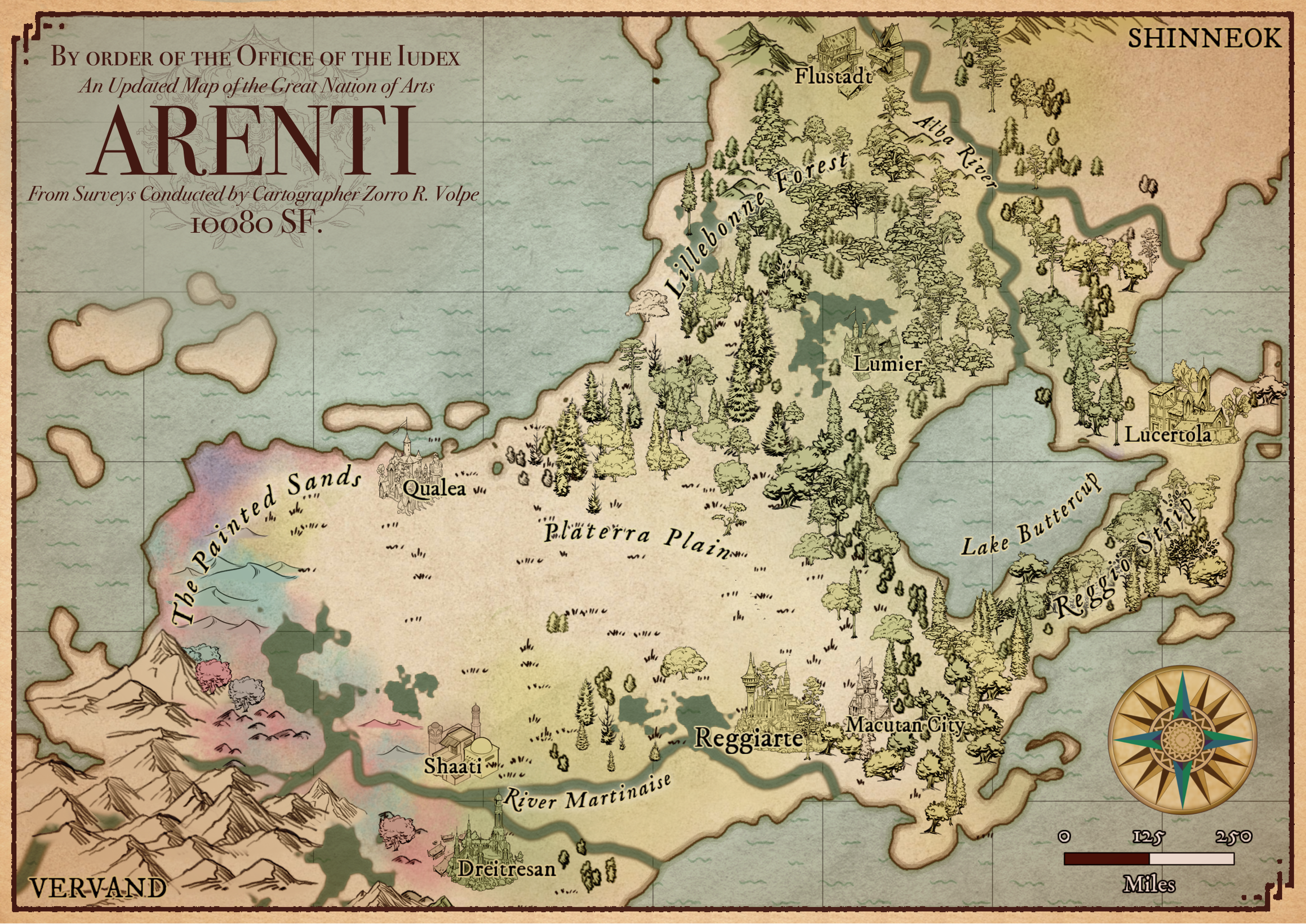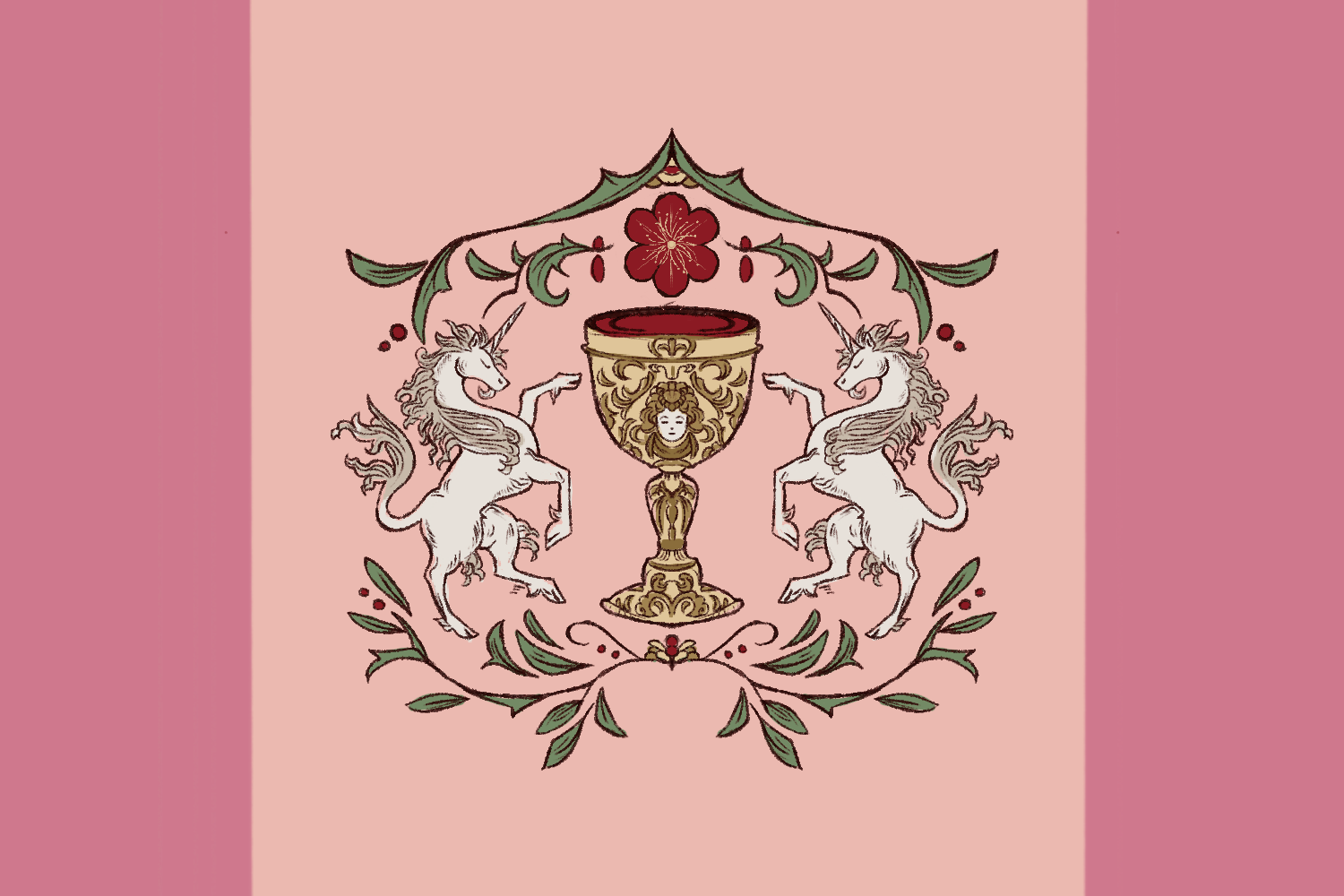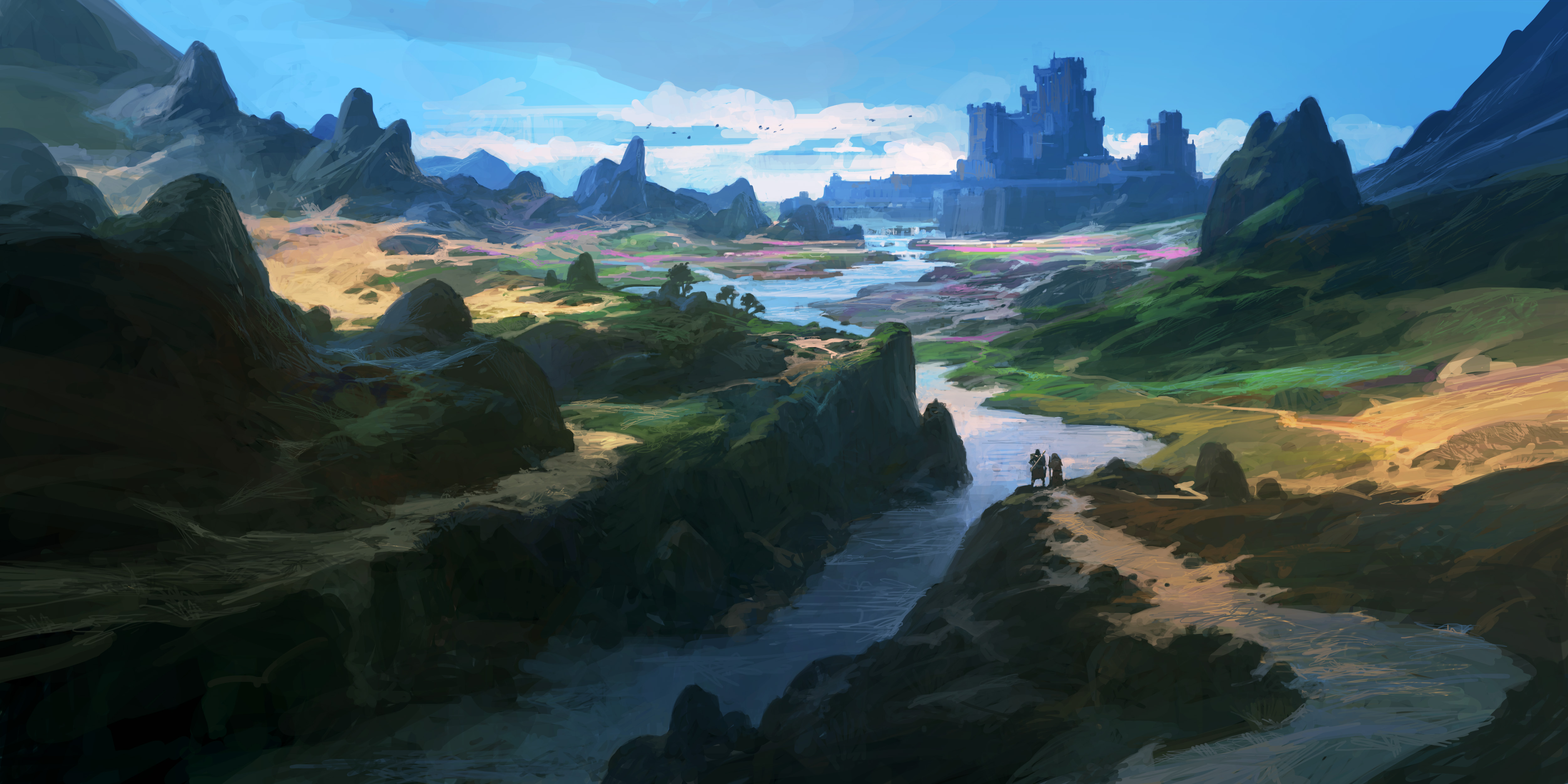Table of Contents
Arenti
- Government Type: Judicial Democracy
- Symbol: Unicorn
- Major Races: Humans, Desert Sandtails
- Capital: Reggiarte
- Demonym: Arentian
Overview
Just northeast of Vervand, past the Crideann Mountains, is the land of Arenti, known far and wide for its art and culture. The land of Arenti itself is partly arid where it lies in the rain shadow of the mountains, part rolling, wind-blown plains, and part lush temperate forest. The massive Lake Buttercup is located on the eastern coast of Arenti, around which are a multitude of settlements.
The arid region of Arenti is famously called The Painted Sands, as legendary artist Mystíc Raphael dyed the desert a beautiful mosaic of colors. After his death, many aspiring artists still clamor to paint the sands and carry on the tradition - the Painted Sands are a testament now to the art of Arenti.
The Raphael School of Arts is a well known school that focuses on a multitude of creative pursuits. Only the most skilled and prodigious minds are able to enroll. One must be invited to audition to enter the school, and even receiving this invitation is a mark of one's artistic prowess. Those that graduate are said to become history making artists: five-star chefs, world-famous musicians, genre-defining directors, and the like.
Unicorns
Arenti’s national animal and main symbol is the unicorn. Considered a rarity throughout the rest of Cayhali, the vast fields of the Arenti countryside are home to droves of the majestic creature. Horses, meanwhile, are much harder to find in Arenti.
Arenti’s unicorns are known to communicate with each other telepathically. On rare occasions, they will speak to other creatures they see as worthy, though a very deep bond must be developed between the two before the unicorns feel comfortable with the idea.
Unicorns are known to be a bit picky in who they let ride them. Given their intelligence, the rider does not pick the unicorn, rather the unicorn picks the rider. Sometimes, the would-be rider is forced to change a significant aspect of themselves before the magical beings will allow one to mount them.
The unicorns of Arenti are also known to slightly shapeshift in order to better fit their rider. A strong warrior, filled with muscles and clad in heavy armor will find their mount to be much larger than most, very strong, and quite hearty. Quick types who are better suited to sneaking around and moving nimbly will find the unicorn is silent on its feet, much faster than normal, and gains an almost chameleon-like camouflage.
Regions
Arenti has four provinces officially recognized by the Arentian government.
Reggio
This province covers the eastern coastline of Arenti. It is the most populous region, and also has the highest amount of recorded history about it. The area has the Alba river, which flows from Lake Buttercup in the north. The area is hot, dry, and sunny during the summer months, receiving most of its rain in the colder parts of the year.
Amonsa
The northwestern portion of Arenti borders Vervand via the Crideann Mountains. This side of the mountains is more arid due to said mountains. Very few towns exist in Amonsa given the arid nature, but it certainly is the most biodiverse part of the country. It is hot almost year round, and receives very little precipitation, to boot.
The Painted Sands
Located slightly north of the Crideann Mountains, the Painted Sands is one of Arenti’s most beautiful landmarks. It was initially named as such due to the exposed and heavily varied soil composition giving off very vibrant colors. In recent years, this has become more literal, as several artists have fled to the sands as a test of skill, usually leaving behind some sort of painting in the sand. These usually don’t stay for long, due to being blown away, but it is a nice retreat for some. It is unknown if any civilization has been established in the sands, as it has yet to be thoroughly explored.
Platterra
Platterra is the flattest region of the country. Because of this, it is perfect for both agriculture and for raising horses. Many of Arenti’s horses and unicorns are bred in the Platterra region. As such, equestrian events are very popular. Platterra is also the wettest of the regions, though admittedly that’s a low bar. Still, Platterra is dotted with many small lakes and streams that eventually feed into the Alba River.
Laws & Governance
For the past millennium, Arenti has been ruled by the People’s Republic of Arenti. It is a type of representative democracy: specifically a parliamentary republic. Each of the country’s major regions serve as larger districts. These large districts are divided into smaller districts for a few distinct purposes. Members of the parliament are chosen to represent each smaller district. These elections happen every five years. As of late, the judicial system has seized far more power than before, with the Iudex (or High Judge) being the national leader.
As of 2558, the Arentian Iudex is Judge Chrysanthe Félicien Roux, a human woman in her mid-60s.
Arenti does not have much in the way of military power. After their extremely blood-filled history, the leaders during the New Republic began to put less of a focus on military efforts. Whilst images of old Arenti soldiers riding on war-unicorns still decorate the halls of many government buildings and murals, this is an image from a bygone era. Arenti’s military is very small compared to its two neighbors, having the smallest of the three members of the Oxis. Most of Arenti’s current laws are very basic. A lot of them are either newer, or are common laws found everywhere.
The country’s national police force is a large connected group known as the Inspecteurs. The process of joining the Inspecteurs is quite rigorous, requiring many background checks and a good education. The Inspecteurs are more similar to detectives than common police officers. While they are technically the city’s official “enforcers,” they only enforce the lower level crimes, such as theft, property damage, or weapon ownership. For more serious crimes, such as treason or abuse crimes, the Inspecteurs enlist the help of the Maru. A non-exhaustive list of some of the crimes of Arenti and their punishments follow:
- Theft: 5-10 days incarceration and/or a fine equal to the worth of the stolen goods.
- Open worship of demons, eldritch beings, or fey entities: 5 gc per month whilst staying in Arenti, 10 gc per month whilst maintaining a permanent residence in the country.
- Carrying a weapon in public: 3 months incarceration and confiscation of said weapon.
- Damage to property, private or governmental: 3 months incarceration and a fine equal to twice the worth of the property destroyed. A notable exception is graffiti. Not only is graffiti legal, it is usually encouraged by local governments - Arentians see graffiti as something that beautifies and enhances a city.
- Assault: 5 years incarceration or a fine up to 250 gc.
- Severe mistreatment of individuals (hate crime, domestic abuse, etc.): Remedial classes and either 7 years incarceration or a fine of up to 500 gc.
- Murder and rape: Incarceration for life.
- Treason: Incarceration for life.
- Ownership of another intelligent humanoid creature: Execution or exile from Arenti for life.
The way that one dresses, talks, and holds themself in Arenti is very important; the citizens view being put together yet unique to be as important as basic hygiene.
For more information on the history and culture of Arenti, see this document: Arenti History & Overview
Cities of Arenti
Reggiarte, Birthplace of the Land: There is a saying in Arenti: “all roads lead to Reggiarte”. The largest city and the capital of the nation, Reggiarte is the only place in the country with an accredited mages' college. What's more, the primary branch of the Raphael School of the Arts is located here. Reggiarte is a big mover of Arenti's primary draw: artistic and cultural exports.
- Macutan City: A small, independent city within the borders of Reggiarte. It serves as the head of the Ninite church in Arenti. It is the closest thing Arenti has to a holy city.
Lucertola: A major economic power and the trading center for the country. Originally founded by the Adelbert empire, the city was built on a marshland, putting the streets underwater and forcing many to traverse the city via small boats. This has become a tourist attraction in recent decades, with many coming to Lucertola for the novelty of canal streets and relaxing gondola trips.
Shaati: A city that has been around for thousands and thousands of years, new being built upon the old. A haven for archaeologists seeking to unearth the secrets of Arenti's past. It is said to have been founded by a great hero from the past named Mustaw. Shaati is known for having some of the finest architecture in the world, as well as amazing dancers.
Qualea: Once a Dahabi military base during imperial occupation, this city is now famous for its many museums, as well as a vibrant nightlife. Artists across the nation clamor to have their work displayed in one of Qualea's famous institutions, where they know it will be appreciated and preserved.
Lumier: Home to most of Arenti’s scientists and inventors. Because of this, it is a major industrial center. It is also known for a vast amount of literature and plays, being very experimental with music, and constantly competing with Qualean cuisine.
- Villailles: An area briefly used by a king of the New Order as a home for his palace, is currently nothing more than a Lumier suburb. It has a massive public stable that used to belong to the king.
Flustadt: A city near the Shinnean border with many hot springs and a massive castle reported to have been inhabited by a great Arentian or Shinnean king in the past - few can agree which, and even fewer can agree exactly who the individual was even within the two camps.
The Arentian countryside, near the Crideann Mountains, in the height of springtime. By Andreas Rocha; used with permission.
Culture
Everything You Can Imagine
Arenti is famous for its lavish artworks of all kinds. Arenti is known for finding a way to turn almost anything into an art form. Even the most mundane of objects are filled with small intricacies. Everything from painting and sculpting, to music and dance, to architecture and cooking are filled with flair. Even inventing and weaponsmithing are decorated heavily. It is said that the low amount of weapons Arenti produces are still the most beautiful, constantly ordained with gold and jewels. Traditional artists, such as painters, tend to receive most of their money from either wealthy patrons or the government themselves, as they commission large artworks to be done on buildings. A similar story lies with the sculptors, the musicians, and the architects.
Despite how prolific art is to Arenti, there is only one formal school for it, in Lumier. Outside of the singular city, artists tend to learn from apprenticeship experience rather than a formal schooling in how to perfect the craft.
Arenti’s style is constantly changing. Within the last few decades alone, fashion has changed dramatically, music has spawned hundreds of new genres, and new machines are made almost daily. To sum it up, Arenti’s modern take on artwork is to constantly advance. Push forward to new ideas and new creations.
Sic Semper Tyrannis
The people of Arenti have no love for rulers. After a long and varied history of absolute rulers, from monarchs to dictators, Arenti’s people have sworn to uphold liberty, democracy, and to constantly be critical of those in power. If a leader does not actively work to fulfill their promises, it is unlikely that they will be re-elected.
Arenti’s citizenry are not just critical of their own government, but of the rest of Cahyali’s countries. Pthora and Ley’Ork are considered by most citizens to be backwards locations that toss away justice and liberty. There are several Arenti-founded charities dedicated to assisting refugees from these countries, assisting them through a program to help them become full citizens with proper jobs.
Religion
Despite being the birthplace of the Ninite church, Arenti has become much more secular compared to its history. In the past, Arenti’s Ninite church led the country almost through theocracy. The mainstream Cahyalic faith was considered heretical, and demon worship was punishable by death. However, this all changed after the end of the Forty Year’s War, when the church lost much of its power. Now, there is a distinct separation between the church and the state. Other religions are widely accepted across the country, with demon worship now being technically legal, as long as one pays a small tax.
Many monasteries and palaces are filled with visages of Arenti’s native faith through many paintings. Sculptures of people from ancient legends of the church dot the cities, especially Reggiarte. Most of Arenti’s churches put less an emphasis on spires and more on domes and lavish archways. Overall, the largest impact the religion has had on modern day Arenti was sparking an interest in developing and expanding the arts.
In the modern day, Ninism does not proselytize much, as many followers are aware that mainstream Cahyalic faith may see their beliefs as heretical. In addition, many Ninites view mainstream belief as mostly true, just a little misguided, and elect not to fight that particular battle too hard.
In Arenti, the Saints do not all receive an equal amount of worship. While there are none that go completely without recognition, Saint Almar and Saint Arakh are the most widely praised. Saint Thoth is most widely worshiped in Reggiarte, while Saint Vormaxia is popular in Lumier. Saint Tenebrus has gained a larger following in recent years, especially in Qualea. The rest have worshippers who are quite scattered. Saint Peregrinus and Saint Marutuk receive the least praise, with many in the modern era finding certain aspects of the two to be against what the country stands for.



